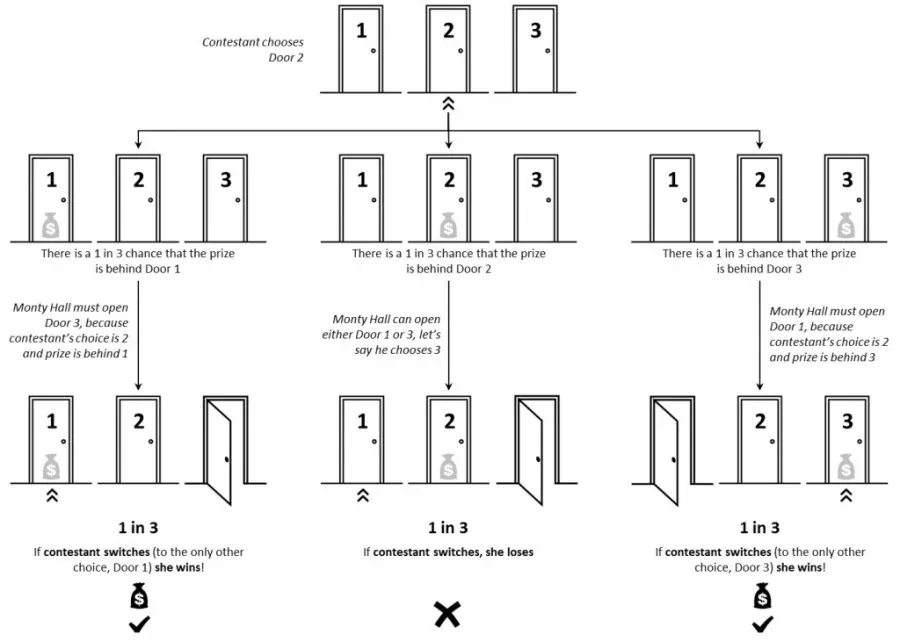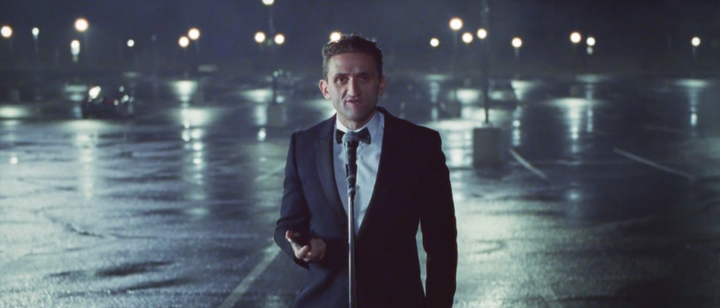Dealing with failure in innovation and the Monty Hall problem

Innovation literature is flooded with various arguments on why and how you should take risk as a company. As someone who’s depending on the success of the companies I work with (sometimes I even presume much more than their own management), I can’t avoid being one of these risk evangelist. The problem essentially is always the same. Risk is waved on principles as a good thing supported by plethoras of well-thinking weak sauce arguments. Inevitably, all these arguments are swiftly shelved when real work needs to be done.
When real work needs to really be done, teams go back to incremental thinking within the current corporate vanilla innovation process, trying to meet next quarter’s internal KPIs while sipping luke-warm coffee from their “Move fast break things” mugs.
And what else could be done?
Do you trust the latest fad on how multi-billion dollar problems should be solved by flocks of startups working on bean bags in the new fancy offices you’re building? Do you believe that your five 3D printers are shaking things up in your R&D department? Has your last Silicon Valley learning expedition sparked a turnaround strategy for the next five years?
If we cut the bullshit propaganda you know that being ranked a top innovator by Forbes or the likes doesn’t help. In the end, moving the cultural needle away from ‘playing safe’ is unacceptable.
That being said, in all the articles, training, keynotes and plain consulting I’ve been doing for ten years, I believe that my ratio of letting companies connect with the need of leveraging risk as a fuel to innovation is probably just slightly over 50%. And if you know anything about corporations, let’s agree it’s kind of surprisingly good. At the same time, it’s insufferably low for my personal taste.
I went over this problem many, many times with different approaches and have recorded marginally better outcomes over the years. To be honest, I shall probably live with the reality that innovation eventually is not for everyone, even when every single company depends on it to adapt and evolve to the constant stream of market changes they face.
But, hell no.
Lately, I’ve been trying a tangential approach to allow companies crack the cultural code of risk and innovation.
What if trying to dumb it down by explaining how chess and go differ and hope that it will spark an epiphany for an executive committee was counter-productive? What if jumping right into the deep end of the pool was preferable? Because in the end, I’m not meeting a whole lot of dumb people in Fortune 500 companies (you’d be surprised). And it’s even getting worse with startups, where the smartest of the smartest start to congregate with this idea of giving a shot at building their own multi-billion dollar thing.

What if we’d just start with the fact that innovation is a chaotic (yet manageable) version of the Monty Hall problem?
The Monty Hall problem is famous for being one of the most efficient way to connect with the fact that for the vast majority of us, probabilistic thinking is unnatural. It goes like this:Imagine you're playing a TV show game where you’re presented with three closed doors A, B, C and you can pick one of your choice. Behind one of them is a brand new car, behind the other two… nothing. The idea is that when making the choice of opening A, B, or C, you have ⅓ chance of getting the car and ⅔ of getting nothing.
And yes, so far you’re right.But now the TV host decides to mess with your brain and if you chose door A, he will open door B to show that it's empty. He also asks: “After this reveal, do you want to reconsider your choice and pick C instead of A?”
At this point, the answer is obvious and it’s ’whatever’… because if your odds have certainly improved since B was opened, it only means the car is beyond A or C, which leaves you with ½ chance of winning either way. Switch, don’t switch, A or C? If the game is not rigged and that no one backstage is moving the car being another door depending on your choice, it’s all the same.
Now, you actually made THE mistake: you should switch.
The mistake you make is that you reset the universe and consider that you’re facing a new problem where the car is behind one of two doors.
But you can’t reset the universe.
You still have ⅓ chance that the car is behind A (your first choice) and ⅔ of chance that the car is behind B or C… Except, that now you know it’s not behind B, so the ⅔ chance of winning applies to C only, not to B and C:

Where our logic fails is at maintaining the continuity at play in the unfolding of the game. After a door is opened, the car doesn’t move around, nor the game resets. You are just equipped with more information.
Now back to innovation.
Consider the doors as possible strategic paths to explore unknown parts of the market and uncover where is your next innovation (the car). Consider the TV host as the market itself that will progressively disclose what he doesn’t want (the empty door). And finally, consider the door you pick as the prototype you want to build to explore, because you don’t have infinite resources and can’t open all doors at the same time.
See where we are going?
Building prototype A, seeing along the way that the market doesn’t want B, and that C is yet to be explored, gives you much more information on possible outcomes on A.
To be clear this is not a Monty Hall problem exactly anymore, because unlike the TV host knowing where the car is, the market doesn’t know where the next innovation will be. So you may not want to switch away from your prototype A because you just learned that a competitor doing B failed. You could, but you might also want to stick to your initial choice of A with better reasons to do so. The foolish alternative would be to stick with your A business plan, blindfolded to the unfolding of the market and information accumulating around you.
In that sense, failing is already not only OK, but critically important to probe how the market unfolds.
Knowing that B happened, you might declare that A won’t work as expected and you have to actually go to C… or D, or Z.
And wait, it gets actually even better.
In real life, you’re not exploring the future of your market with a single prototype A, but many of them. It might be different divisions working on different approaches, different prototypes around the same idea, different strategic paths in different countries, and/or startups that you have invested in to secure extra bets. So, you’re not only playing with only three doors but hundreds of them. And the extra good news is that you might not uncover a ‘car’, but also scooters, bikes, skate boards… or space shuttles, teleporting belts, and space warps.
You are betting on a reasonable amount of doors (subset A), monitoring the market and detecting the small and big reveals (subset B), and depending on what you learn through A or B, you will switch or pivot your bets to the yet unexplored doors (subset C), or kill some of the As and reinforce others.
You’re not betting once every five years and hope you’ll be right in the end, you screen possibilities detecting false positives and negatives. These are the failures you need to harvest and leverage. You “just” have to make sure that you monitor doors opening and understand what’s behind.
The only alternative for failure is staying blind and playing an impossible lottery.
As a cool side effect, the fact that in innovation we’re working with many, many doors, should also help you better understand the mathematics of the Monty Hall problem:
Imagine that you now play with 1,000,000 doors rather than 3 and that there’s still only 1 car. When you pick a door, now the TV host opens 999,998 of the remaining doors. It gets easier to digest that 999,999 times out of 1,000,000, the remaining door will hide the car and that your incentive for switching is tremendous.
Regarding the difficulty we have to grasp the maths beyond all this, researchers proposed that it’s our working memory demand that is taxed during the Monty Hall problem and that our brain prefers to “collapse” its choices in simple options. What is very interesting is that they also report that when the number of options is increased to more than 7 doors, people tend to switch more often. Which is very much in line with my experience in term of innovation: when teams start to work on multiple projects, instead of very big one that (against all mathematical common sense) should be a winner, they start to have a more fluid and adaptative approach to innovation.
In the end, failure is information, information builds up an asymmetrical edge for your innovation bets, and sustaining this edge eventually opens a path that pays off.
And when you’ll need to get there, be sure to use the right tools.



